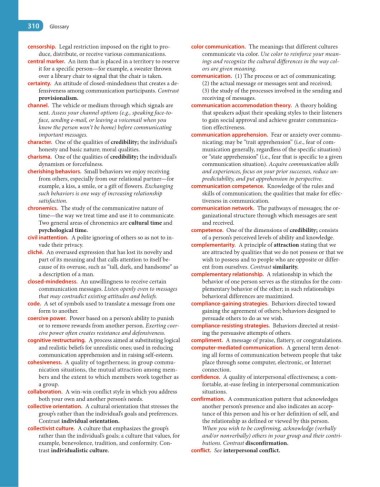Page 331 - Essentials of Human Communication
P. 331
310 Glossary
censorship. Legal restriction imposed on the right to pro- color communication. The meanings that different cultures
duce, distribute, or receive various communications. communicate via color. Use color to reinforce your mean-
central marker. An item that is placed in a territory to reserve ings and recognize the cultural differences in the way col-
it for a specific person—for example, a sweater thrown ors are given meaning.
over a library chair to signal that the chair is taken. communication. (1) The process or act of communicating;
certainty. An attitude of closed-mindedness that creates a de- (2) the actual message or messages sent and received;
fensiveness among communication participants. Contrast (3) the study of the processes involved in the sending and
provisionalism. receiving of messages.
channel. The vehicle or medium through which signals are communication accommodation theory. A theory holding
sent. Assess your channel options (e.g., speaking face-to- that speakers adjust their speaking styles to their listeners
face, sending e-mail, or leaving a voicemail when you to gain social approval and achieve greater communica-
know the person won’t be home) before communicating tion effectiveness.
important messages. communication apprehension. Fear or anxiety over commu-
character. One of the qualities of credibility; the individual’s nicating; may be “trait apprehension” (i.e., fear of com-
honesty and basic nature; moral qualities. munication generally, regardless of the specific situation)
charisma. One of the qualities of credibility; the individual’s or “state apprehension” (i.e., fear that is specific to a given
dynamism or forcefulness. communication situation). Acquire communication skills
cherishing behaviors. Small behaviors we enjoy receiving and experiences, focus on your prior successes, reduce un-
from others, especially from our relational partner—for predictability, and put apprehension in perspective.
example, a kiss, a smile, or a gift of flowers. Exchanging communication competence. Knowledge of the rules and
such behaviors is one way of increasing relationship skills of communication; the qualities that make for effec-
satisfaction. tiveness in communication.
chronemics. The study of the communicative nature of communication network. The pathways of messages; the or-
time—the way we treat time and use it to communicate. ganizational structure through which messages are sent
Two general areas of chronemics are cultural time and and received.
psychological time. competence. One of the dimensions of credibility; consists
civil inattention. A polite ignoring of others so as not to in- of a person’s perceived levels of ability and knowledge.
vade their privacy. complementarity. A principle of attraction stating that we
cliché. An overused expression that has lost its novelty and are attracted by qualities that we do not possess or that we
part of its meaning and that calls attention to itself be- wish to possess and to people who are opposite or differ-
cause of its overuse, such as “tall, dark, and handsome” as ent from ourselves. Contrast similarity.
a description of a man. complementary relationship. A relationship in which the
closed-mindedness. An unwillingness to receive certain behavior of one person serves as the stimulus for the com-
communication messages. Listen openly even to messages plementary behavior of the other; in such relationships
that may contradict existing attitudes and beliefs. behavioral differences are maximized.
code. A set of symbols used to translate a message from one compliance-gaining strategies. Behaviors directed toward
form to another. gaining the agreement of others; behaviors designed to
coercive power. Power based on a person’s ability to punish persuade others to do as we wish.
or to remove rewards from another person. Exerting coer- compliance-resisting strategies. Behaviors directed at resist-
cive power often creates resistance and defensiveness. ing the persuasive attempts of others.
cognitive restructuring. A process aimed at substituting logical compliment. A message of praise, flattery, or congratulations.
and realistic beliefs for unrealistic ones; used in reducing computer-mediated communication. A general term denot-
communication apprehension and in raising self-esteem. ing all forms of communication between people that take
cohesiveness. A quality of togetherness; in group commu- place through some computer, electronic, or Internet
nication situations, the mutual attraction among mem- connection.
bers and the extent to which members work together as confidence. A quality of interpersonal effectiveness; a com-
a group. fortable, at-ease feeling in interpersonal communication
collaboration. A win-win conflict style in which you address situations.
both your own and another person’s needs. confirmation. A communication pattern that acknowledges
collective orientation. A cultural orientation that stresses the another person’s presence and also indicates an accep-
group’s rather than the individual’s goals and preferences. tance of this person and his or her definition of self, and
Contrast individual orientation. the relationship as defined or viewed by this person.
collectivist culture. A culture that emphasizes the group’s When you wish to be confirming, acknowledge (verbally
rather than the individual’s goals; a culture that values, for and/or nonverbally) others in your group and their contri-
example, benevolence, tradition, and conformity. Con- butions. Contrast disconfirmation.
trast individualistic culture. conflict. See interpersonal conflict.

